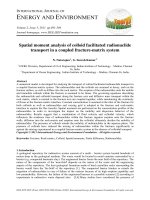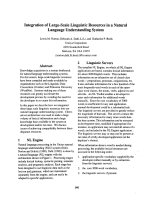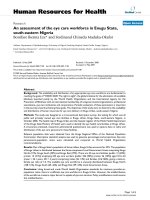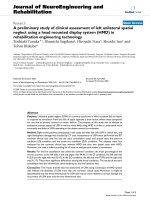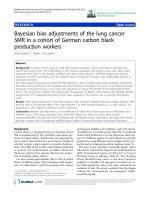Assessment of stress and growth of the eel anguilla anguilla in a closed recirculating aquaculture system
Bạn đang xem bản rút gọn của tài liệu. Xem và tải ngay bản đầy đủ của tài liệu tại đây (44.66 MB, 342 trang )
ASSESSMENT OF STRESS AND GROWTH OF THE EEL
"ANGUILLA ANGUILLA" IN A CLOSED
RECIRCULATING AQUACULTURE SYSTEM
Christopher Graham David
A Thesis Submitted for the Degree of PhD
at the
University of St Andrews
1997
Full metadata for this item is available in
St Andrews Research Repository
at:
/>
Please use this identifier to cite or link to this item:
/>
This item is protected by original copyright
ASSESSMENT OF STRESS AND GROWTH OF
THE EEL Anguilla anguilla IN A CLOSED
RECIRCULATING AQUACULTURE SYSTEM
by
Christopher Graham David
Thesis submitted for the degree of
Doctor of Philosophy
in the University of St. Andrews
July 1996
ProQuest Number: 10166206
All rights reserved
INFORMATION TO ALL USERS
The quality of this reproduction is d e p e n d e n t upon the quality of the copy subm itted.
In the unlikely e v e n t that the a u thor did not send a c o m p le te m anuscript
and there are missing pages, these will be noted. Also, if m aterial had to be rem oved,
a n o te will ind ica te the deletion.
uest
ProQuest 10166206
Published by ProQuest LLO (2017). C opyright of the Dissertation is held by the Author.
All rights reserved.
This work is protected against unauthorized copying under Title 17, United States C o d e
Microform Edition © ProQuest LLO.
ProQuest LLO.
789 East Eisenhower Parkway
P.Q. Box 1346
Ann Arbor, Ml 4 8 1 0 6 - 1346
DECLARATION
a) I, Christopher Graham David, hereby certify that this thesis
has been composed by myself, that it is a record of my own work
and
that
it has
not been
accepted
in partial
or complete
fulfilment of any other degree or qualification.
Signed
Date 23/7/1996
b) I was admitted to the Faculty of Science of the University of
St. Andrews in October 1991 as a candidate for the degree of Ph.D
in October 1991.
Signed
c)
Date 23/7/1996
I hereby certify that the candidate has
fulfilled the
conditions of the Resolution and Regulations appropriate to the
degree of Ph.D
Signed (Supervisor)
Date 23/7/1996
To My Dear Wife Margaret and Loving
Daughters Jodie and Lauren
UNRESTRICTED COPYRIGHT
In submitting this thesis to the University of St. Andrews, I
understand
that
I am giving
permission
for
it
to be made
available for use in accordance with the regulations of the
University Library for the time being in force, subject to any
copyright vested in the work not being affected thereby. I also
understand that the title and abstract will be published and that
a copy of the work may be made and supplied to any bona fide
library or research worker.
ABSTRACT
1 ) Closed recirculating intensive aquaculture potentially offers
major advantages over existing technologies including reduction
in normal production time, reduced water input and output and
beneficial environmental effects.
2)
The major aim of this study was to produce a basic scientific
understanding of the factors that affect intensive recirculating
culture
of the European
eel Anguilla anguilla
in order
to
increase efficiency and economic viability of eel aquaculture in
the E .U .
3 ) Unlike some intensively farmed fish such as salmonids little
is known of the stress factors affecting optimal growth rates in
intensive eel culture. The primary effects of stress are mediated
by corticosteroids and catecholamines which may have profound
effects on growth, appetite and ion and water balance.
4)
Growth rates of the eel Anguilla anguilla were investigated
in closed water recirculating systems utilising fresh water or
saline water (12 ppt)at 23°C. Eels were initially graded into two
similar populations consisting of three categories, small (12 g),
medium (24g) and large (48g) based on initial growth rates.
5)
During a 300 day period the medium and large group's growth
rates were significantly greater in 12 ppt saline water than in
fresh water, although for the small fish group there was no such
difference.
Stocking densities were maintained at commercial
levels of approximately 30-100 kg/m^.
6)
Plasma cortisol concentrations
increased throughout the
growth period in both fresh and saline water, although there were
no significant differences between the two groups during the
experiment. Metabolic clearance rates of cortisol were however
consistently higher in saline water fish.
7)
Both
groups
showed
an
increase
in
plasma
glucose
concentration throughout the experiment. However there were no
significant differences between fresh water and saline water fish
for
plasma
concentrations of
glucose,
free
fatty
acids
or
lactate.
8
)
Eels held at stocking densities of 130 kg/m^ continued to
grow in the saline water whereas the control fish in fresh water
ceased
growing.
The results
suggest
that maintaining water
salinity at 12 ppt in closed recirculating aquaculture systems
produces increased growth rates and possibly increased efficiency
of food conversion.
9)
In response to acute grading stress, plasma osmolality and
glucose concentrations were elevated in both fresh and salt water
groups
20
minutes after grading but returned to pre-grading
values within 90 minutes. Plasma cortisol concentrations were
elevated after 20 and 40 minutes in saline water but returned to
control values after 90 minutes. In fresh water fish, plasma
cortisol
concentrations
were elevated after
20
minutes
and
remained elevated throughout the experiment.
10 ) Acute netting stress (tank transfer) resulted in a transient
increase
transfer.
in
plasma osmolality within
Plasma
cortisol
20
concentrations
minutes
were
after net
significantly
elevated after 20 minutes in saline water but returned to control
values after 60'minutes. In fresh water fish, plasma cortisol
concentrations were elevated throughout the 90 minute period
monitored after net transfer.
11 ) In both cases of acute stress (netting and grading), plasma
catecholamines were elevated within a five minute period after
the stressor was applied.
This study has developed techniques to assess both long-term and
short-term stress in eels and has optimised the environmental
conditions leading to improved growth rates.
performance of recirculating aquaculture
have
been
demonstrated
and suggestions
Improvements in the
for on-growing eels
for
future possible
improvements as a way forward in commercial aquaculture have been
suggested.
These factors will,
hopefully,
lead to increased
economic efficiency and increased profits in eel aquaculture
within the E.U.
ACKNOWLEDGEMENTS
My heart felt gratitude is extended to my supervisor Dr. Neil
Hazon who, during the course of this study and writing of this
thesis, worked constantly to encourage and inspire me. He was
always a calming voice on the end of a telephone. My thanks are
further
extended
to
his
wife
Jill
for
assistance
in
the
preparation of the financial analyses in Chapter 6 .
My thanks are due to my brother and friend Dr. Jonathan David for
useful discussions, encouragement and proof reading.
Many thanks to Jane Williamson for providing considerable (and
cheerful) assistance with the figures and tables. Without Jane's
help, the compilation of this thesis would have been a daunting
task indeed.
Mr. Ian Stevenson is to be thanked for providing the building for
the research facilities and also for the light entertainment
during the course of the study.
My thanks go to Mr. John McHardy for supplying the therapeutic
joinery and wall building work during the writing of this thesis
and for help with printing also many thanks to his wife Edith for
help in keeping my spirit up and laying other solid foundations.
Thanks are also offered to Messers Alan Thornton and John Kirk
for the loan of their printers, enthusiasm and time.
Thanks to my parents for their support during my first degree at
U.C.N.W.
Bangor without which this work would not have been
possible.
I leave to last my undying thanks to my wife Margaret for her
love, support and understanding during the completion of this
work and the 3 a.m system alarm calls. I thank her for being full
of love, joy, peace, patience, kindness, faithfulness, gentleness
and self control.
TABLE OF CONTENTS
Page
CHAPTER 1 - GENERAL INTRODUCTION
1.1
AQUACULTURE: - AN HISTORICAL PERSPECTIVE
1.2
PROBLEMS ENCOUNTERED BY THE SCOTTISH
SALMON FARMING INDUSTRY
1.3
1.5
6
FUTURE DEVELOPMENT OF AQUACULTURE
IN SCOTLAND
1 .4
1
EEL AQUACULTURE
IN EUROPE
13
19
1.4.1
Eel Consumption in Europe
19
1.4.2
Eel Culture inEurope
20
1.4.3
Eel Culture in Japan
21
1.4.4
Life Cycle of the Eel
22
1.4.5
Eel Farming Techniques
26
OBJECTIVES OF THE STUDY
28
CHAPTER 2 - WATER QUALITY AND TREATMENT
2.1
INTRODUCTION
29
2.1.1
Historical Background
29
2.1.2
Water Quality
30
2.1.2a
Nitrogen
32
2 .1 .2 b
Ammonia
32
2 .1 .2 c
Nitrite
36
2 .1 .2 d
Nitrate
40
2 .1 .2 e
Carbon
41
2 .1 .2 f
Phosphorous
42
2 .1 .2 g
Oxygen
44
2 .1 .2 h
pH
47
2 .1 . 2 1
Alkalinity
49
2 .1 .2 ]
Hardness
50
2 .1 .2 k
Temperature
51
2.1.3 Biofiltration
2.1.3a
Mineralisation
54
2.1.3b
Nitrification
55
2.1.3c
Biofilters
59
(i)
(ii)
2.2
Fixed film
59
Activated sludge
60
MATERIAL AND METHODS
2.2.1
52
Principles of Operation
61
61
2.2.1a
Biofilter
61
2.2.1b
Oxygenation
67
2.2.1c
Foam fractionation unit
67
2.2.Id
Treatment of pathogens
70
2.2.2 Description of Equipment Used
71
2.2.2a
Experimental Design
71
2.2.2b
Water Analysis
74
2.3
RESULTS
75
2.3.1
Parameters Measured During the
Development ofSystems
2.3.1a
Nitrogen compounds
75
2.3.1b
pH
75
2.3.1c
Alkalinity
80
2.3.Id
Hardness
80
2.3.2
Parameters Measured in Fully
DevelopedSystems
2.4
75
80
2.3.2a
Ammonia
80
2.3.2b
Nitrite
81
2.3.2c
Nitrate
81
2.3.2d
Oxygen
82
2.3.2e
pH
83
2.3.2f
Salinity
83
2.3.2g
Water temperature
83
2.3.2h
Water quality
85
DISCUSSION
86
CHAPTER 3 - GROWTH RATES
3.1
OSMOTIC AND IONIC REGULATION
3.1.1
The Osmotic and Ionic Environment of
Fish
3.1.2
3.1.3
91
91
Structure and Function of theTeleost
Gill
92
Chloride Cells
94
3.1.4
Osmotic and Ionic Regulation in Fresh
Water Teleosts
3.1.5
Osmotic and Ionic Regulation in Marine
Teleosts
3.1.6
104
Physiological Effects of Different
Saline Environments
3.2
100
Osmotic and Ionic Regulation in
Euryhaline Teleosts
3.1.7
98
HORMONES INVOLVED IN OSMOTIC AND IONIC REGULATION
104
107
3.2.1
Cortisol
107
3.2.2
Prolactin
113
3.2.3
Growth Hormone
11 4
3.2.4
Arginine Vasotocin
115
3.2.5
Renin Angiotensin System
116
3.2.6
Caudal Neurosecretory System
118
3.2.7
Natriuretic Peptides
119
3.2.8
Thyroid Hormones
120
3.2.9
Vasoactive Intestinal Peptide
121
JIALS AND METHODS
122
3.3.1
Growth Rate Experiments
122
3.3.2
Stocking Density Experiments
125
3.3.3
Radioimmunoassay of Cortisol
127
3.3.4
Plasma Analysis
1 28
3.3.5
Statistical Tests
129
3.4 RESULTS
3.4.1
3.4.2
130
Growth Rate Experiment
130
3.4.1a
Growth rates
130
3.4.1b
Mortality rates
132
3.4.1c
Plasma composition
132
Stocking Density Experiments
136
3.4.2a
Growth rates
136
3.4.2b
Mortality rates
140
3.4.2c
Plasma composition
140
3.5 DISCUSSION
144
3.5.1
Growth Rate Experiment
144
3.5.2
Stocking Density Experiments
145
CHAPTER 4 - CHRONIC STRESS
4.1
STRESS IN FISH
147
4.2
CHRONIC STRESS
150
4.2.1
150
4.3
Stocking Density
4.2.2 Water Quality
150
4.2.3 Territorial Behaviour
151
4.2.4 Disease
152
4.2.5 Maturity
152
CORTISOL
4.3.1
153
Role of Cortisol in Chronic Stress
4.3.2 Cortisol Clearance Rates
153
155
4.3.3
Determination of Metabolic
Clearance Rates
4.4
4.5
4.6
155
4.3.3a
By single injection
157
4.3.3b
By constant infusion
157
MATERIALS AND METHODS
159
4.4.1
Experimental Conditions
159
4.4.2
Radioimmunoassay of Cortisol
159
4.4.3
Determination of Cortisol Dynamics
159
4.4.4
Glucose Determination
160
4.4.5
Lactic Acid Determination
162
4.4.6
Free Fatty Acid Determination
162
RESULTS
163
4.5.1
Growth Rate Experiment Population
163
4.5.2
Stocking Density Experiment Populations
167
DISCUSSION
169
CHAPTER 5 - ACUTE STRESS
5.1
ACUTE STRESS
172
5.1.1
Handling
172
5.1.2
Anaesthesia
173
5.1.3
Chemical Treatments
174
5.1.4
Water Quality
174
5.1.5
Temperature
175
5.2
5.1.6
Transport
175
5.1.7
Disease
175
CATECHOLAMINES
177
5.2.1
Adrenocortical Medullary Homologue
177
5.2.2
Structure of Adrenaline and
5.2.3
5.3
5.4
5.5
Noradrenaline
178
Release and Effects of Catecholamines
178
MATERIALS AND METHODS
183
5.3.1
Grading Experiment
183
5.3.2
Netting Experiment
184
5.3.3
Catecholamine Determinations
185
5.3.4
Statistical Analysis
185
RESULTS
186
5.4.1
Grading Experiment
186
5.4.2
Netting Experiment
193
DISCUSSION
200
CHAPTER 6 - DISCUSSION
6.1
ECONOMIC ASSESSMENT
204
6.1.1
Economic Analysis (micro-economic level)
204
6.1.2
On-Growing Eels
204
6.1.3
Economic Analysis (macro-economic level)
207
6.2
FUTURE WORK
6.2.1
211
Future Work to Realise the Commercial
Value of This Research
6.2.2
Future Scientific Research into
Eel Culture
6.3
214
AN OVERVIEW OF TECHNIQUES ADOPTED IN
RECIRCULATION SYSTEMS
6.5
211
PROBLEMS ENCOUNTERED IN ADOPTION OF
RECYCLING SYSTEMS
6.4
211
215
6.4.1
Biofiltration
215
6.4.2
Activated Sludge
216
6.4.3
Fluidised Beds
217
6.4.4
Biodiscs
217
6.4.5
Ultra Violet Treatment
217
6.4.6
Ozonation
219
6.4.7
Ion Exchange Media
221
6.4.8
Denitrifying Filters
222
CONCLUSION
225
APPENDIX 1
227
BIBLIOGRAPHY
228
LIST OF FIGUEtES
Page
FIGURE 1:1
The life cycle of the European eel
Anguilla anguilla
FIGURE 2:1
Cross Section and Plan View of the
Stahlermatic Biofilter and Clarifier
FIGURE 2:2
63
Individual Components of the Stahlermatic
Contact Aerator (Wheel) of the Biofilter
FIGURE 2:3
23
64
Cross Section of the Stahlermatic Contact
Aerator (Wheel) Displaying Principles of
Operation
FIGURE 2:4
Cross Section of "Oxibox" Aeration Unit
Displaying Principles of Operation
FIGURE 2:5
65
68
Cross Section of Foam Fractionation Unit
(Protein Skimmer) Displaying Principles of
Operation
FIGURE 2:6
Schematic Diagram of the Closed Recirculating
Aquaculture System Used in The Study
FIGURE 2:7
69
72
Concentration of Ammonia, Nitrite and Nitrate
During the Development of the Biofilter in
Fresh Water
76
FIGURE 2:8
Concentration of Ammonia, Nitrite and
Nitrate During the Development of the
Biofilter in Salt Water
FIGURE 2:9
77
Concentration of Ammonia and pH Values
During the Development of the Biofilter
in Fresh Water
FIGURE 2:10
78
Concentration of Ammonia and pH Values
During the Development of the Biofilter
in Salt Water
FIGURE
3:1 Schematic
Representation of Gill Lamellae
FIGURE
3:2 Schematic
Representation of a Chloride
Cell of a Marine Teleost
FIGURE
3:3 Schematic
97
99
Route and Mechanism of Salt Extrusion
Across the Gill in a Sea Water Fish
FIGURE 3:6
95
Possible Mechanisms for Ion Uptake in the
Gill of Fresh Water Fish
FIGURE 3:5
93
Representation of Na*-K+-ATPase
Enzyme
FIGURE 3:4
79
103
Diagrammatic Representation of the
Interaction of Primary, Secondary
and Tertiary Consequences ofStress
108
FIGURE 3:7
Interrelationships and Formation of the
Steroid Hormones
FIGURE 3:8
110
Increase in Average Body Weight for
Initially Small, Medium and Large
Populations in Either Fresh Water
or Saline Water (12 ppt)
FIGURE 3:9
131
Histogram to Show the Development of
Initially Small, Medium and Large
Populations in Fresh Water and
Saline Water (12 ppt)
FIGURE 3:10
133
Plasma Osmolality and Chloride Concentration
During Growth in Either Fresh Water or
Saline Water (12 ppt) for Eels in the Medium
Population
FIGURE 3:11
134
Change in Average Weight Gain of Fish in
Fresh Water and Saline Water (12 ppt) at
Increasing Stocking Densities
FIGURE 3:12
137
Change in Average Weight of Fish Grown in
Fresh Water (Tank 2) and Saline Water
(12 ppt) (Tank 8 ) at a Stocking Density of
130kg/m^
141
FIGURE 4:1
Typical Experiment to Determine the Clearance
Rate of Radioactivity from Plasma After a
Single Injection of 4mCi
Cortisol
FIGURE5:1
Structure of Adrenaline and Noradrenaline
FIGURE 5:2
Acute Grading: Plasma Cortisol Concentration
in Either Fresh or Saline Water (12 ppt)
FIGURE 5:3
161
179
187
Acute Netting: Plasma Cortisol Concentration
in Either Fresh or Saline Water (12 ppt)
FINANCIAL ANALYSIS 6:1
194
205
LIST OF TABLES
Page
TABLE
1:1 Historical Milestones in Aquaculture
TABLE
2:1 Variation in percentage NH3 in an Aqueous
Ammonia Solution With Temperature and pH
TABLE
35
2:2 Solubility of Oxygen in Fresh and Sea Water
at 100% Saturation
TABLE
2
45
2:3 Water Quality Parameters - Maximum and
Minimum Recommended Levels in a Closed
Recirculating Aquaculture System
TABLE
53
2:4 Commonly Used Compounds Used in the Treatment
of Fish Diseases and Their Effects on the
Nitrification Capacity of the Biofilter
TABLE
3:1 Size and Composition of BP Nutrition Fry
Diets Used in Study
TABLE
58
124
3:2 Plasma Osmolality and Chloride Concentration
During Growth in Either Fresh Water or
Saline Water (12 ppt)
135
